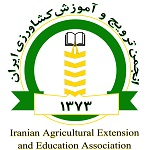

Volume 13, Issue 1 (2024)
QJIA 2024, 13(1): 69-87 |
Back to browse issues page
Download citation:
BibTeX | RIS | EndNote | Medlars | ProCite | Reference Manager | RefWorks
Send citation to:



BibTeX | RIS | EndNote | Medlars | ProCite | Reference Manager | RefWorks
Send citation to:
motaghed M, Choobchian S. Examining Experts Views on Challenges in Managing Water Security Risks in Farming Exploitation Units of Hamedan Province. QJIA 2024; 13 (1) :69-87
URL: http://journal.sbkiran.ir/article-1-263-en.html
URL: http://journal.sbkiran.ir/article-1-263-en.html
Tarbiat Modares University
Abstract: (348 Views)
In the past decades, the climate change has affected the stability of the production of the agricultural sector, especially the water security component of the exploitation units in global scale and in Iran. In this regards, the present study was conducted with the aim of investigating the perception of water resources experts about the challenges of water security risk management in the agricultural exploitation units of Hamedan province during 2022-2023. The population and the statistical sample of the research were 100 and 80 subject matter experts and professionals from three Rural Cooperative Organizations, a Regional Water Joint Stock Company, and a Provisional Agricultural Jihad Organization in Hamedan province. Questionnaires were completed using a simple random method. A researcher-designed questionnaire was the primary research tool, validated by a team of sustainability experts and faculty members from the University of Tehran and Tarbiat Modares University. Reliability was assessed through Cronbach's alpha coefficient and composite reliability, with data analysis conducted using SMARTPLS3 and SPSS25 software. The results showed that among the independent variables studied, the "managerial-social" indicator with an influence coefficient of 0.76 (β = 0.76) had the greatest role in explaining the dependent variable (total challenges of water security risk management in operating units of Hamedan province). Then, the "technical-infrastructural", "environmental-agricultural", and "economic-financial" indicator respectively. Therefore, policy makers and agricultural insurance fund planners can reduce the challenges of water security risk management by adopting appropriate strategies in each sector.
Keywords: Climate Change, Managerial-Social Indicator, Technical-Infrastructural Indicator, Environmental – Agricultural Indicator, Economic – Financial Indicator, Farming Exploitation Units.
Send email to the article author
| Rights and permissions | |
 |
This work is licensed under a Creative Commons Attribution-NonCommercial 4.0 International License. |




